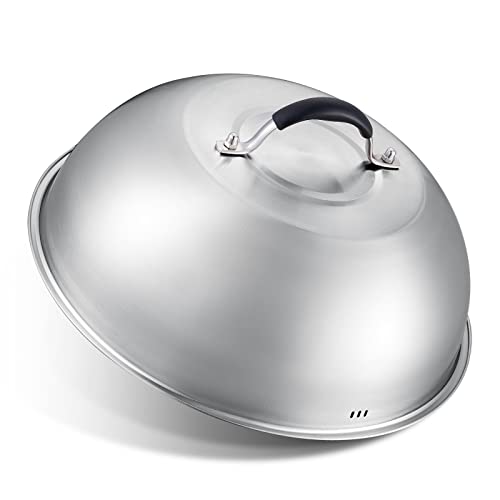Now that we’ve taken a look at some of the top basting covers out there, let’s examine our buying guide for the ideal basting domes for your kitchen. With so many options out there, it may be confusing how to choose a single product that will meet all your requirements. Therefore, we carefully researched the market to offer you a detailed guide that will equip you with all the necessary information about basting covers, their uses and needs, and how to pick the right one for yourself.
What Is Basting?
Before jumping into any discussions about basting domes, let’s clarify what basting is. Basting is a cooking method that allows food, mostly meats, to cook in its moisture content and juices; this also includes the fat content pressed out of the meat during smashing. Covering the meat with a conductive surface traps heat and evenly distributes it throughout the meat, or patty, and enables cooking without drying out.
Why Do You Need a Basting Cover?
A basting cover, or steam cover, is required to cook meat, prepare patties, and melt cheese. You can also use a basting dome to steam or saute vegetables on a grill or stovetop. You can also use basting covers to infuse the flavor of different seasonings and toppings on a burger, using a process called fluid fusion. You can also mix and melt different cheeses into your burger or sandwich with a basting cover.
How To Use a Basting Cover
Basting covers are used differently depending on the kind of cooking involved. This means that a basting cover will be used differently for a burger than for cooking a larger cut of meat. If you’re grilling patties on a stovetop or grill, you should use a basting dome after flipping one side. After flipping once, you can cover the grill or stovetop with the basting dome and let it stay in place for about 3 minutes. If you want to add cheese to your patties, you should add your slice of cheese after flipping a patty. You can then cover it with the basting cover and let the patty cook. You can also garnish your sides, or vegetables, with a little vegetable oil and seasoning, letting them sit under the basting cover until they are deliciously sauteed.
How To Pick the Right Basting Cover
There are several features you must consider before making the final decision on a basting cover for your kitchen. Here are all the factors you need to take into consideration:
Shape
The most important feature of a basting cover is its shape. The shape should always be round, allowing for even heat distribution within the food. This is also why basting covers are also called basting domes, they are most commonly shaped like a dome for optimal performance.
Size
The size of your basting cover should be enough for your food to be centered under the cover. This means, on average, for a 6-inch patty or burger, a basting dome with a diameter of 12 inches is perfect. This is the usual size of most basting covers and is good enough to heat a decent amount of food simultaneously and evenly. The size should also be supported by your cooking appliance, whether it’s a grill or stove. If it can support a basting cover bigger than 12 inches, you can opt for that. If not, you need to ensure that the basting cover will fit on your particular appliance.
Material
The material of the basting cover determines how well heat is trapped and retained as your food cooks. Normally, basting domes are made of stainless steel or aluminum. These materials are non-reactive to heat other than conducting it, ensuring no added metallic taste to your food. They can also endure intense heat without breaking or cracking. Other metal materials might become hazardous, breaking and mixing with your food.
Handle
While this isn't a strict requirement, having a nonconductive handle can make your basting cover experience safer and more comfortable. A wooden, or heat-resistant plastic handle, allows you to remove the basting cover even when hot. Conversely, if the handle is also made of metal, you may require additional gear like gloves to grip the handle.





